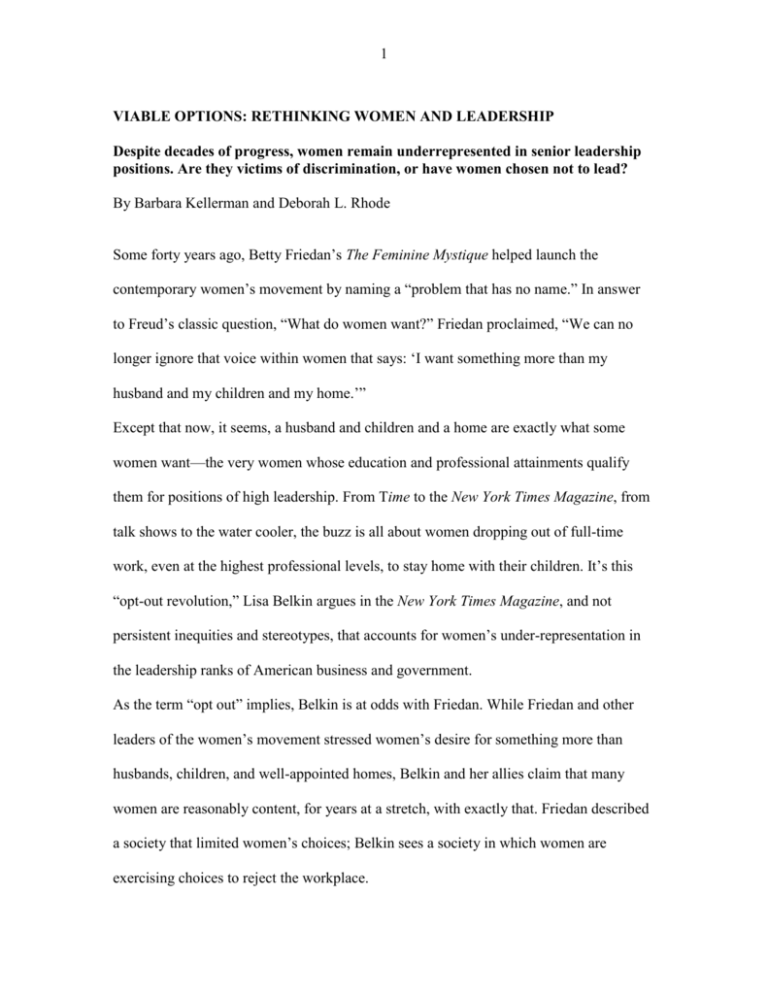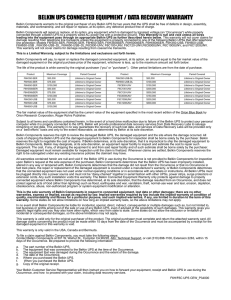A Talk by Deborah Rhode and Barbara
advertisement

1 VIABLE OPTIONS: RETHINKING WOMEN AND LEADERSHIP Despite decades of progress, women remain underrepresented in senior leadership positions. Are they victims of discrimination, or have women chosen not to lead? By Barbara Kellerman and Deborah L. Rhode Some forty years ago, Betty Friedan’s The Feminine Mystique helped launch the contemporary women’s movement by naming a “problem that has no name.” In answer to Freud’s classic question, “What do women want?” Friedan proclaimed, “We can no longer ignore that voice within women that says: ‘I want something more than my husband and my children and my home.’” Except that now, it seems, a husband and children and a home are exactly what some women want—the very women whose education and professional attainments qualify them for positions of high leadership. From Time to the New York Times Magazine, from talk shows to the water cooler, the buzz is all about women dropping out of full-time work, even at the highest professional levels, to stay home with their children. It’s this “opt-out revolution,” Lisa Belkin argues in the New York Times Magazine, and not persistent inequities and stereotypes, that accounts for women’s under-representation in the leadership ranks of American business and government. As the term “opt out” implies, Belkin is at odds with Friedan. While Friedan and other leaders of the women’s movement stressed women’s desire for something more than husbands, children, and well-appointed homes, Belkin and her allies claim that many women are reasonably content, for years at a stretch, with exactly that. Friedan described a society that limited women’s choices; Belkin sees a society in which women are exercising choices to reject the workplace. 2 Jamie Gorelick, a former high-ranking official in the Clinton-era Justice Department and a member of the independent 9/11 investigative commission, might be the poster child for Belkin’s revolution. In 2003, she left her position as vice chair of Fannie Mae and declined to be considered for its COO post, explaining to Fortune magazine that she had two children and didn’t want that “pace in my life.” The “dirty little secret,” she added, “is that women demand a lot more satisfaction in their lives than men do.” Who is correct, Friedan or Belkin? Is the relative shortage of women leaders in government and private enterprise the result of discrimination, or have women chosen not to lead? The two answers, we suggest, are not mutually exclusive. Our findings do not lead us to suspend the struggle to expand women’s opportunities for power, authority, and influence. Rather, we argue for reframing the problem of leadership to account for both gender biases, which can be addressed through greater equity in the workplace and in society more generally, as well as gender differences, which must be addressed through greater diversity in the workplace and society. To gain a sense of the interplay of the two forces, we consider where women are now, why we are where we are, and what needs to change. Progress and Frustration In the forty years that have passed since Friedan’s manifesto, American society has experienced a transformation in gender-related attitudes, practices, and policies. About 16 percent of Fortune 500 corporate officers are now women; that percentage has doubled over the last decade. The percent of women holding top corporate positions—executive vice-president to CEO—quadrupled during the same period, up from 2 percent to over 8 3 percent. Eight Fortune 500 companies have a female chief executive, compared with only two in 1995. Women hold fourteen Senate seats and sixty House seats in the 108th United States Congress. Women now constitute nearly 14 percent of members of Congress, up from 10 percent in 1992, and nearly one-quarter of the members are women of color. Twenty-one percent of college presidents are female, compared with almost none a decade ago. But progress has been partial and painfully slow. With respect to leadership, in particular, women still have a long way to go. Almost a sixth of the Fortune 500 companies still have no female officers. Fewer than 2 percent of corporate offices are held by AfricanAmerican, Asian-American, or Hispanic women. The vast majority of women in top jobs in corporate America hold staff jobs rather than the line positions that typically produce CEOs. Women account for just 6 percent of the top corporate earners. In academia, women faculty members earn 14 percent less than men. Despite four decades of equal opportunity legislation, the workforce remains segregated and stratified by gender. Women are over-represented at the bottom and under-represented at the top, even controlling for educational qualifications. The best-trained women are still concentrated in different kinds of jobs than men—jobs with less pay, status, and power. As for politics and government, the United States ranks fifty-ninth in the world in electing women leaders. Congress gained three fewer women in the last decade than it did in the single 1992 election, the fabled “year of the woman.” Fewer women ran for state legislative offices in 2000 than did in 1992, and the number of women in state politics has been stagnant at about 20 percent for the last decade. 4 What accounts for such persistent and pervasive disparities? Why, forty years after Friedan wrote of the problem that has no name, have we done so well at labeling the problem, but are still so far from solving it? For one thing, gender bias has not been—and cannot be—legislated away. Women remain underrepresented in positions of leadership in part because of the mismatch between the characteristics traditionally associated with women and the characteristics traditionally associated with leadership. As Rakesh Khurana has observed, the “great man” model of leadership—the heroic savior—is still with us. And the term “man” is not used generically. Although recent theories of leadership stress interpersonal qualities commonly associated with women, such as cooperation and collaboration, most qualities associated with leaders are still masculine: dominance, authority, driving ambition, unflinching decisiveness, fierce determination, and so on. Such expectations of leaders confront women with a double standard and a double bind. They may appear too soft, unable or unwilling to make the tough calls required in positions of greatest influence. Or if they mimic the male model, they are often viewed as strident and overly aggressive. An overview of more than a hundred studies confirms that women are rated lower when they adopt stereotypically masculine authoritative styles, particularly when the evaluators are men or when the woman’s role is one typically occupied by men. Since other research suggests that individuals with masculine styles are more likely to emerge as leaders than those with feminine styles, women face tradeoffs that men do not. Even in experimental situations where male and female performances are objectively equal, women are held to higher standards, and their competence is rated lower. 5 Many women internalize these stereotypes, which creates a self-fulfilling prophecy. Researchers consistently find that most women see themselves as less deserving of rewards than men are for the same performance. On average, female workers are also less willing to take the risks, or to seek the challenges, that would equip them for leadership roles. Commentators who focus on women’s choice to leave the workplace typically fail to acknowledge the social forces that constrain it. Women are, and are expected to be, the primary care givers, especially of the very young and very old. Many men are committed to equality more in principle than in practice; they are unwilling or (in their own view) unable to structure their lives to promote it. If, as Belkin and others insist, women are choosing not to run the world, it is partly because, to paraphrase Gloria Steinem, men are choosing not to run the washer-dryer. Double standards in domestic roles are deeply rooted in cultural attitudes, managerial policies, and social priorities. Fewer than 15 percent of Fortune 100 companies offer the same paid parental leave to fathers as to mothers, and an even smaller percentage of men take any extended period of time away from their jobs for family reasons. As one director of professional development noted, the traditional expectation was that fathers with newborn infants would “just go to the hospital, take a look, and come right back to work.” This pattern no longer holds, but workplaces that only grudgingly accommodate mothers can be even more resistant to fathers. Daddy tracks are noticeable for their absence. As one man put it, it is now “okay [for fathers] to say that they would like to spend more time with the kids, but it is not okay to do it, except once in while.” 6 As long as work-family issues are seen as problems primarily for women, potential solutions are likely to receive inadequate attention in decision-making structures still dominated by men. Within those structures, caretaking is considered primarily an individual rather than a social responsibility, adding to women’s work in the home and limiting their opportunities in the world outside it. America is almost alone among industrialized nations in failing to guarantee paid parental leaves. And high-quality, affordable childcare is unavailable for many women attempting to work their way up the leadership ladder. Over the past forty years we have made more progress in getting women access to roles traditionally occupied by men than in getting men to assume domestic roles traditionally occupied by women. And we have made even less progress in altering social policy to accommodate the needs of both sexes on family-related issues. The resilience of traditional gender patterns is reflected in two especially telling sets of statistics. Threequarters of women have a spouse or a partner with a full- time job; three-quarters of men have a spouse or a partner who spends at least part time at home. Almost a fifth of women with graduate or professional degrees are not in the paid labor force; only five percent of similarly credentialed men have opted out. What Price Power? Various researchers have attempted to find a biological basis for this achievement gap. But for every bit of data that supports the hypothesis that gender roles are biologically determined, there is at least as much data to challenge it. More compelling is a growing body of research that challenges conventional views that women want just what men 7 want. Put another way, if women are underrepresented in leadership positions, the reason is not simply that men stand in their way. Recent surveys indicate that many women, especially women with young children, are not sufficiently determined to get to the top. For a variety of reasons, women are often ambivalent about seeking power and making the sacrifices necessary to obtain it. There is countervailing evidence for this hypothesis as well. A recent survey by Catalyst, a New York research group that studies gender and workplace issues, reports that a majority of senior executives want to become their employer’s chief executive. The numbers remain roughly the same whether the respondents are male or female, childless or not. Those findings, says Catalyst, seem to challenge “the assertion that there aren’t more women at the top because they don’t want to be there.” But it is important to note that the survey sample consisted of those who already had made the choices necessary to become senior executives. Belkin’s small sample was skewed in the other direction. It consisted of an Atlanta book group of full-time homemakers with Princeton degrees, a group of San Francisco mothers with MBAs, and “countless” readers with whom the author had corresponded. All were well educated and economically privileged women who could afford to choose to leave the paid workforce because their high-earning partners chose differently. Such selective samples preclude definitive conclusions. Countering both the Catalyst and Belkin arguments are studies that suggest that at least some differences in women’s and men’s positions in the workplace reflect different choices, many of which involve small children. A recent Fortune magazine article 8 described a number of such studies and then raised the heretical question: “Do women lack power in business because they just don’t want it enough?” As the article acknowledged, the very question comes treacherously close to blaming the victim. But the signs that women have mixed feelings about conventional measures of workplace achievement are too striking to ignore. For example, Catalyst recently reported that about a quarter of women not yet in senior posts say they don’t want those jobs. About a fifth of the hundred-odd women who have appeared on the Fortune 50 over the past five years have left their prestigious positions, generally of their own volition. And a recent survey by Fast Company identifies a significant minority of high-ranking women who have not opted out entirely, but have chosen a life less consumed by work—which means, among other things, a life less consumed by leadership. Such studies reinforce a conclusion unnerving to many feminists: when women aren’t in positions that carry the greatest power, authority, and influence, it is not always because women can’t get them; it is sometimes because they don’t want them. The question is why. At least some of the reasons take us back to the gender roles and stereotypes with which we began. First and foremost, forever foremost, there are the children. Women both bear the children and remain their primary caretakers. Most women want to have at least one child, and they are increasingly aware that involved parenting is difficult for anyone at the top. The difficulties of reconciling family and leadership responsibilities are starkly demonstrated by the demographics. Fully 42 percent of high-achieving women in corporate America are childless at the age of forty. Moreover, among those who do have 9 children, 40 percent feel that their husbands create more work around the house than they contribute. Men, in contrast, do not experience the same conflict between success and parenting; or to put it more pointedly, between leadership and parenting. In one representative survey, 79 percent of high-achieving men reported wanting children—and 75 percent had them. Motherhood, it is apparent, entails more significant personal and professional implications than does fatherhood, which in turn affects access to leadership. More women than men drop out of the paid work force, typically for periods ranging from several months to several years. More women than men work part time. And more women than men leave large organizations to strike out on their own for jobs with fewer and more flexible hours. Yet family considerations are not the only reason that women appear less committed than men to climbing the leadership ladder. The gender biases noted earlier take a toll as well. Women who do seek leadership are slammed for seeming overly ambitious or aggressive. Others decline to risk the negative evaluations that such “unfeminine” styles evoke. That’s not the whole story, though. Many women are less professionally ambitious than men because they are more personally ambitious than men. They dream of making a difference in ways that are personally more meaningful than achievement in conventional corporate and professional settings. Many women also have personal commitments and interests that seem impossible to reconcile with the all-consuming demands of leadership roles. The Path to Leadership 10 Of course, only economically privileged women confront such questions as whether to work, how much to work, and whether to pursue leadership roles in the paid labor force or in the community. Yet the women who have those options also tend to be the ones with the greatest education and the best chance of achieving leadership positions. They were expected to be the role models, and if they did hold positions of power they could, in theory at least, create change for the benefit of others. Ruth Mandel, a pioneer in the field of women’s studies, has well captured the current dilemma, an impasse partly created by women who could aim higher, but opt not to: “Nothing will change the picture of leadership and perhaps the practice of leadership unless women themselves choose to pursue leadership. In the United States, far and away, this matter of women’s choice stands as the single greatest remaining challenge to achieve parity for women in leadership….I am not saying that women at one time were choosing to lead and now are not. I am saying that today women can enter a path to leadership that has been cleared of many of the old impediments. They confront more opportunities and options than ever before. Nonetheless, women must choose to walk the path.” We have argued that the reasons for women’s still limited access to power, authority, and influence reflect both gender biases and gender differences. For women to gain ground at the leadership level, they must pursue two related but distinct, strategies. Women must fight against gender biases by demanding equity; and they must fight for recognition of gender differences by demanding accommodation of diversity. These battles should be intertwined, fought simultaneously, and planned strategically, with tactics that are both political and legal. 11 The goals that women should be fighting for are substantially the same as those that inspired the contemporary women’s movement. They include: Changes in public policy concerning equal opportunity enforcement, affirmative action, quality child and elder care, paid family leave, and meaningful part-time work Changes in organizational policies that increase those organizations’ commitment to equity and diversity and that place a priority on accommodating workers with significant family, community, or other socially valued commitments. Changes in the academy to support research on gender-related issues, particularly the socialization patterns, workplace practices, and public policies that could promote gender equality and a better quality of life for both sexes. Changes in individual and group behaviors that will revitalize the women’s movement and enable it to work more effectively toward shared goals. 12 To promote those goals, the law can be an important tool, but its effectiveness should not be overstated and the need for its reform should not be underestimated. Legal prohibitions on sex-based discrimination and harassment, and legal entitlements concerning family leave and affirmative action remain crucial forces in the struggle for equal employment opportunity. Multimillion-dollar victories in class action lawsuits like those against Merrill Lynch, Salomon Smith Barney, and Morgan Stanley, and the pending litigation against Wal-Mart, send a powerful message about the price of gender inequities. Women must continue to pursue such remedies while also pressing for changes that would make the law more effective in enhancing employment opportunities. As experts have frequently noted, our current legal framework is a highly inadequate response to “second-generation” sex discrimination, which is based less on demonstrable prejudice than on unconscious stereotypes and workplace structures that are gender neutral in form but not in fact. For the vast majority of victims, the difficulties of proof are insurmountable, or the financial and psychological costs of litigation are prohibitive. Women who pursue more informal internal remedies often experience an arbitration or mediation system stacked against them; employers control the system and are generally adept at minimizing the risk of adverse decisions, substantial financial liability, and unfavorable publicity. For victims who lack the resources to pursue litigation, federal and state enforcement agencies are a poor backup; their resources are insufficient to pursue more than a small fraction of complaints. And even the rare women who win in court often end up losing in life, given the informal blacklisting and unflattering personal disclosures that may result from litigation. 13 Many hard-won legal guarantees remain limited in scope. The federal Family and Medical Leave Act still leaves more than half of the labor force unprotected. It provides job security only to those who can afford to take unpaid leave and excludes individuals who work for small employers or in part-time positions. And temporary-leave provisions do little to solve the long-term needs of those with substantial childrearing or elder care responsibilities. There are no simple solutions. Gender-related laws remain too limited in scope and too expensive in application to reach most of the causes of women’s underrepresentation in leadership positions. But we can certainly work to make those laws more effective and accessible. We can insist on greater resources for governmental enforcement agencies. We can provide financial contributions to women’s rights organizations that litigate important cases and lobby for essential reforms. We can press for legislative mandates and workplace policies that will ensure more equitable informal dispute resolution systems. And we can support candidates for political and judicial positions who are committed to gender equality and the legal strategies that might help achieve it. Expanding parental leave entitlements and childcare programs, creating tax incentives for family-friendly workplace policies, and mandating more affirmative action in fields where women are underrepresented are obvious priorities for a society that is committed to equal opportunity in practice as well as principle. Legal reforms cannot be obtained without political strategies. Our agenda, while ambitious, should be viewed in context. We do not see most American women as downtrodden. We realize that more than a few American women control large sums of money and that many (ourselves included) have very good jobs. And we are certainly 14 aware that, by global standards, the overwhelming majority of American women are extremely well off. But in terms of basic gender equity, American women still have a long way to go. And neither governmental policy nor business practices ensure that women (or men for that matter) can care adequately for their families and participate actively in their communities while exercising leadership roles. Women are not well positioned to address that problem. Despite their numerical majority, women still lack the positions of influence, both in the public or private sectors, necessary to achieve the agenda set forth above. That, in turn, means that women need to employ strategies most readily available to those without conventional sources of leverage. We refer to three in particular: First, women must envision themselves as agents of change. Instead of reconciling ourselves to unequal burdens in the home and to unequal pay, status, and power in the world outside, we need to demand gender equity and the strategies necessary to achieve it. Second, women must be ready, willing, and able to take a stand. The first step is a revival of old-fashioned consciousness-raising. We need to increase awareness of gender inequities and inspire a passion for challenging them. This will, in turn, require some willingness to assume short-term risks in the interest of long-term gains. As political theorists and activists across the globe remind us, there are no substitutes for speaking truth to power. Of course, that strategy must be selective. In order to reach positions of influence, women need to target their efforts and pick battles that they have some prospect of winning. But the challenge is to succeed within organizations without losing 15 the capacity or commitment to change them. Silence in the face of inequality can only perpetuate it. Third, women must take collective action. Fundamental change begins with individual commitment, but it requires group efforts. Women need to be more strategic in forging alliances and enlisting the collaboration of other individuals, small groups, and large organizations in the interest of common causes. Since the 1960s, both national and grassroots women’s groups, all with their own particular missions and constituencies, have dramatically increased in size and number. But there has been insufficient unity even around key issues, and equally insufficient attempts to involve women from different points along the socioeconomic and demographic spectrum. We need also to include men in our struggle. Women must insist, endlessly it seems, that the most crucial women’s issues are issues not only for women. They are concerns in which both sexes have a stake. Increasing numbers of men want more balance in their lives. And their families, communities, and workplaces would benefit greatly if they achieved it. As a growing body of research makes clear, balanced lives serve bottom lines; they reduce employers’ training and recruitment expenses and improve workers’ health and productivity. A diverse workforce serves equally important objectives. In today’s increasingly competitive global economy, no organization can secure long-term success with policies that penalize half of the talent pool for leadership. We cannot know with any certainty what, in an ideal world, women would truly want. But in this far from perfect world, we know well enough what women do not want— enough to forge a constructive agenda for reform. Forcing professionals of either sex to 16 opt on or off leadership tracks as they are currently structured is not the answer. Choice on these terms is not a solution. It is part of the problem. Barbara Kellerman is Research Director at the Center for Public Leadership and Lecturer in Public Policy at Harvard University’s John F. Kennedy School of Government. Deborah L. Rhode is Ernest W. MacFarland Professor of Law and Director of the Stanford Center on Ethics at Stanford University.











